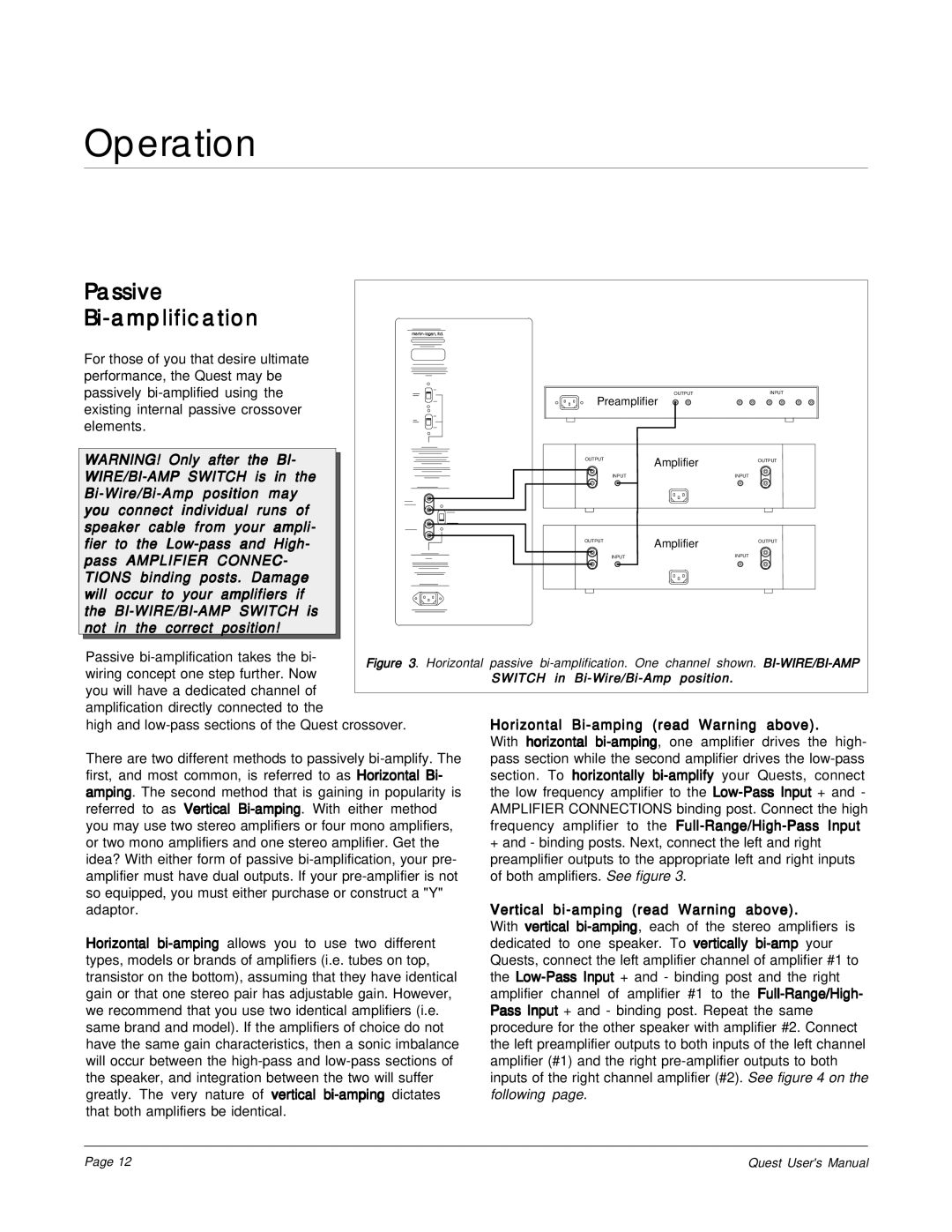
Operation
Passive |
|
|
|
|
|
For those of you that desire ultimate |
|
|
performance, the Quest may be |
|
|
passively | OUTPUT | INPUT |
existing internal passive crossover | Preamplifier |
|
|
| |
elements. |
|
|
WARNING! Only after the BI- | OUTPUT | Amplifier | OUTPUT |
INPUT |
| INPUT | |
|
|
| |
you connect individual runs of |
|
|
|
speaker cable from your ampli- |
| Amplifier |
|
fier to the | OUTPUT | OUTPUT | |
pass AMPLIFIER CONNEC- | INPUT |
| INPUT |
TIONS binding posts. Damage |
|
|
|
will occur to your amplifiers if |
|
|
|
the |
|
|
|
not in the correct position! |
|
|
|
Passive | Figure 3. Horizontal passive | ||
wiring concept one step further. Now | |||
| SWITCH in | ||
you will have a dedicated channel of |
|
| |
|
| ||
amplification directly connected to the |
| Horizontal | |
high and | |||
There are two different methods to passively | With horizontal | ||
pass section while the second amplifier drives the | |||
first, and most common, is referred to as Horizontal Bi- | section. To horizontally | ||
amping. The second method that is gaining in popularity is | the low frequency amplifier to the | ||
referred to as Vertical | AMPLIFIER CONNECTIONS binding post. Connect the high | ||
you may use two stereo amplifiers or four mono amplifiers, | frequency amplifier to the | ||
or two mono amplifiers and one stereo amplifier. Get the | + and - binding posts. Next, connect the left and right | ||
idea? With either form of passive | preamplifier outputs to the appropriate left and right inputs | ||
amplifier must have dual outputs. If your | of both amplifiers. See figure 3. | ||
so equipped, you must either purchase or construct a "Y" | Vertical | ||
adaptor. |
| ||
Horizontal | With vertical | ||
dedicated to one speaker. To vertically | |||
types, models or brands of amplifiers (i.e. tubes on top, | Quests, connect the left amplifier channel of amplifier #1 to | ||
transistor on the bottom), assuming that they have identical | the | ||
gain or that one stereo pair has adjustable gain. However, | amplifier channel of amplifier #1 to the | ||
we recommend that you use two identical amplifiers (i.e. | Pass Input + and - binding post. Repeat the same | ||
same brand and model). If the amplifiers of choice do not | procedure for the other speaker with amplifier #2. Connect | ||
have the same gain characteristics, then a sonic imbalance | the left preamplifier outputs to both inputs of the left channel | ||
will occur between the | amplifier (#1) and the right | ||
the speaker, and integration between the two will suffer | inputs of the right channel amplifier (#2). See figure 4 on the | ||
greatly. The very nature of vertical | following page. | ||
that both amplifiers be identical. |
|
| |
Page 12 | Quest User's Manual |
